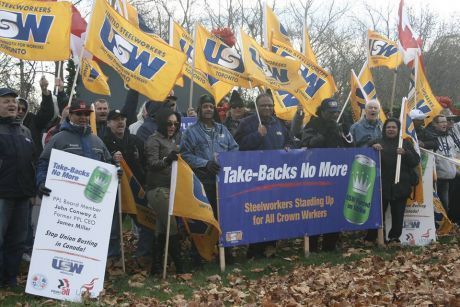Columns
You are here
Lessons of the Crown strike

August 28, 2015
The Crown strike is over after 22 long months and the workers fought til the very last. Only two crossed the line out of 120 and the strikers understood that they were fighting not only for themselves but for every worker in this country.
The vote was close: 53 to 45. Crown, a vicious employer, had targeted 34 activists who they had refused to take back, and were demanding that all the scabs keep their jobs. Its intent was to break the union because the workers stood up and fought back.
In the end the tentative agreement contained a lot of concessions including wage cuts, and lost both the defined benefit pension plan and “30 and out” pension eligibility. It was a bitter pill to swallow, but all the strikers who choose have their jobs back and the scabs will be gone. After almost two years on the line workers bit the bullet and accepted the agreement with no strikers left behind.
They were clearly split on the contract but were very comradely to each other even though they voted differently in the end. Some in the leadership of the Steelworkers wanted to end it long ago, which could have led to a total defeat.
Campaign
In the fall of 2013 the Steelworker Toronto Area Council took a bus load of members including strikers to the US picketing a Crown Plant in Massachusetts, Crown headquarters in Philadelphia and a director’s company in Allentown, Pa. The strikers maintained this type of activity throughout the strike. In many ways the membership ran the strike on the ground. There were committees set up to keep the line going at the plant, do picketing at operations that used the scab cans, do solidarity work in the US and other areas of Canada. Workers who never took part in union activities in the past became activists through the strike.
There was a “bottles not cans campaign” with beer stores throughout the province being leafleted by workers from many communities. But broader solidarity in the labour movement was slow to build until about six months ago when the Toronto and York Region Labour Council called on trade unions to step up the solidarity. Other unions set up pickets three days a week at the Minister of Labour’s office for months. The strikers occupied and picketed Liberal MPP’s constituency offices. More momentum was built and a lot of pressure was put on the company and the Liberal government.
There was also international solidarity with strikers visiting a plant in Turkey to show solidarity with Turkish workers who had organized their workplace. That support was reciprocated in actions by those workers. Unite, a major union in the United Kingdom and Ireland, held demonstrations against Crown plants in the UK. This gave confidence to the workers in Toronto that they were not alone.
Lessons
There is much to be learned about the need for solidarity from the start, showing that it is not just 120 workers who are facing off against the employer but the entire union movement. The USW leadership has to understand, as do all leaders, that these battles need the active support of every union. It is the work on the ground that will make the difference and an inability to move quickly can lead to disaster. This is critical to the battles ahead.
There will undoubtedly be more strikes ahead because the austerity agenda corporations and government around the world are imposing on workers and the poor is not stopping. Building rank-and-file strength on the ground is the key to any fight back. It is the workers themselves who are facing the battles and have so much to loose.
The attacks on both public and private sector workers are unrelenting, but when workers show up on each others strike lines they build connections that aren’t soon forgotten. The workers at Crown know they create the wealth that the stockholders benefit from and that pays the $12 million yearly salary of the CEO. They understand the battle going on between the 99% and 1% in this country and around the world and they fought for themselves and their class.
The rank-and-file was very active in this fight, more so then in most strikes today, and for 22 long months. Many of the strikers have become activists and are committed to supporting workplace struggles wherever they may occur. They have given their heart felt thanks to those fellow workers who resisted with them though thick and thin. They are going to remain active in the Toronto and York Region Labour Council and the Steelworker Toronto Area Council.
It was a tough battle with significant losses. Many lessons have been learned for the battles that are sure to come. The workers are going back with their heads held high knowing that they fought back and fully understand the meaning of solidarity.
Section:










